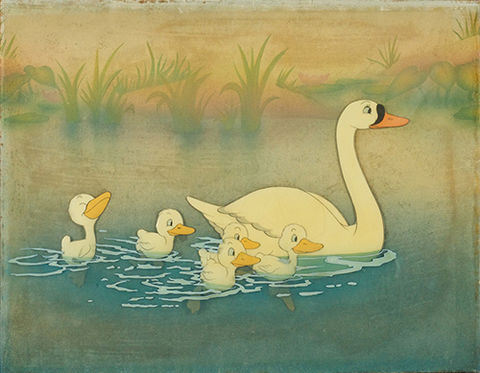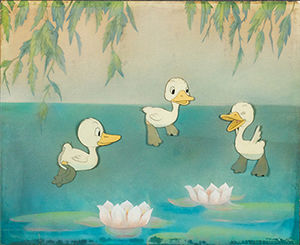
Walt Disney was at the helm of the most transformative period in American animation history, often referred to as “the golden age” of animation. Following the successful debut of Mickey Mouse with Steamboat Willie on November 18, 1928, Walt saw that the opportunity to push the animation medium to new artistic boundaries and—in a bold and unprecedented move—launched a series without a central character: the Silly Symphonies.
As Walt released the first short, aptly named The Skeleton Dance (1929), he was not without his detractors. It befuddled many that at the same time Walt wrote the formula for success with Mickey’s universal appeal, he was immediately disregarding that formula for a passion project. But Walt knew that while Mickey could keep the lights on, the promise of what the animated cartoon could accomplish under his supervision was worth pursuing. He was interested in experimentation and pushing the boundaries of animation and the art of storytelling.
Early in the Sillies’ run, Walt, quietly and to little fanfare, released The Ugly Duckling (1931), a cartoon very loosely based on the Hans Christian Andersen fairy tale. Released before Flowers and Trees (1932), The Ugly Duckling was in black-and-white and completed before artists received formal training given at The Walt Disney Studios’ art school, established that same year by Don Graham. Released before Three Little Pigs (1933), it utilized very little character animation and did not have the advantage of storyboards to plot the action and pacing. Released before The Old Mill (1937), it did not have the advantage of the multiplane camera to establish a greater illusion of depth. What it did have was the raw, direct energy and good humor of the early Silly Symphonies.

The second production of The Ugly Duckling, released in 1939, included all of the Studios’ innovations of the prior decade as well as lessons learned from the production process of their first feature film—Snow White and the Seven Dwarfs—released nearly a year and a half earlier. This resulted in a new subtlety and sophistication, rich Technicolor, and compelling character animation.
Walt’s re-do of The Ugly Duckling was the final Silly Symphony before the Studios’ focus shifted almost entirely on feature film production and won Walt his eighth competitive Academy Award®. To learn more about The Ugly Duckling and other groundbreaking Silly Symphonies, please visit Gallery 3 in our main museum.

Chris Mullen
Guest Experience Associate at the Walt Disney Family Museum
Sources
Barrier, Michael. Hollywood Cartoons: American Animation in Its Golden Age. New York: Oxford University Press, 1999. pp. ix-x, 4.
Thomas, Bob. Walt Disney: An American Original. New York: Simon and Schuster, 1976. pp. 96, 99-100, 115, 116, 134.
"1923-1928 - Gallery 2: The Move to Hollywood." The Walt Disney Family Museum. 2016. http://www.waltdisney.org/galleries#gallery02.
"1928-1940 - Gallery 3: Exploring New Horizons." The Walt Disney Family Museum. 2016. http://www.waltdisney.org/galleries#gallery03.
"1936-1938 - Gallery 4: The Transition Into Features." The Walt Disney Family Museum. 2016. http://www.waltdisney.org/galleries#gallery03.
"Wish Upon a Star: The Art of Pinocchio." The Walt Disney Family Museum. May 18, 2016. http://waltdisney.org/exhibitions/wish-upon-star-art-pinocchio.
